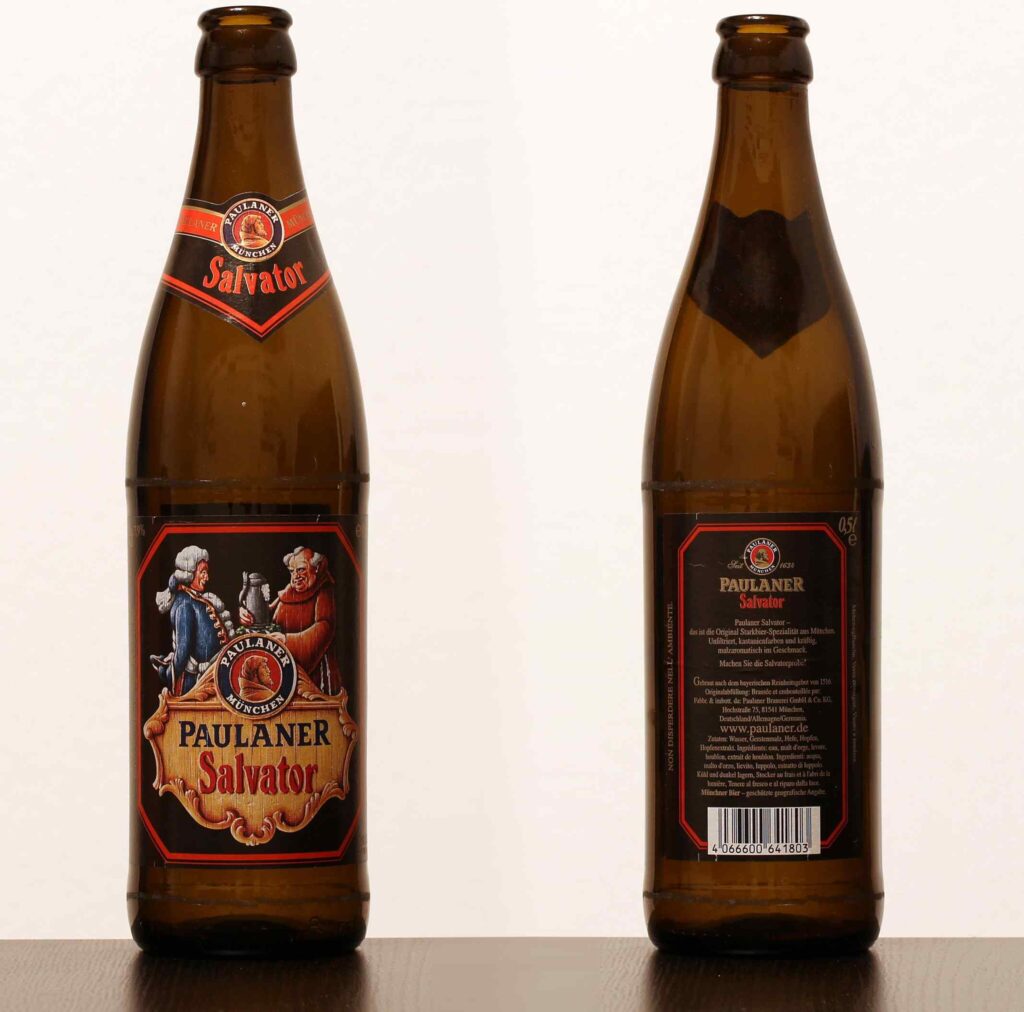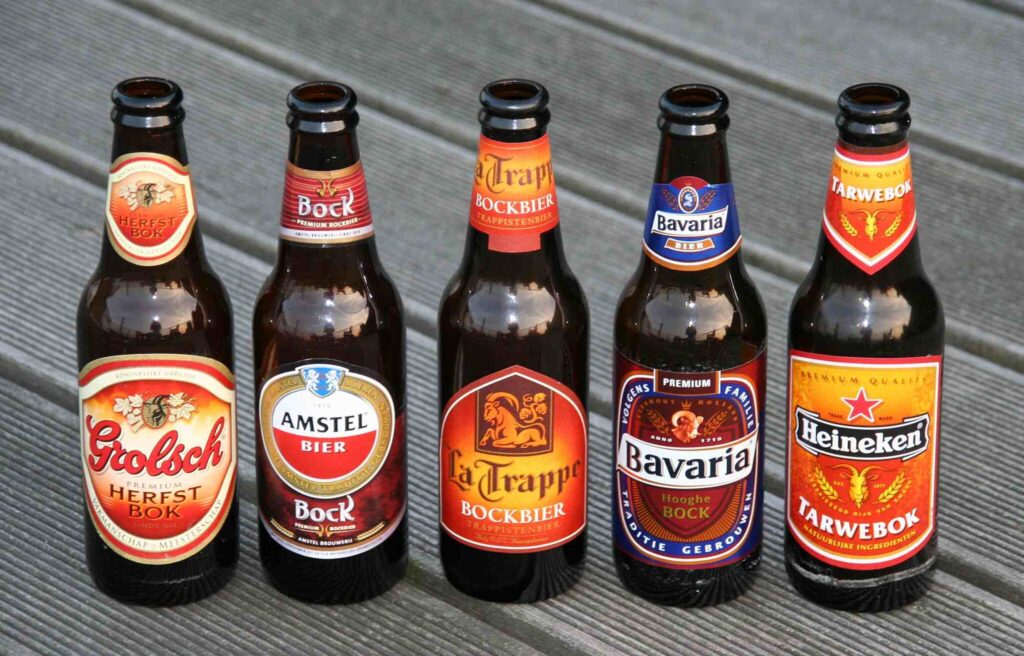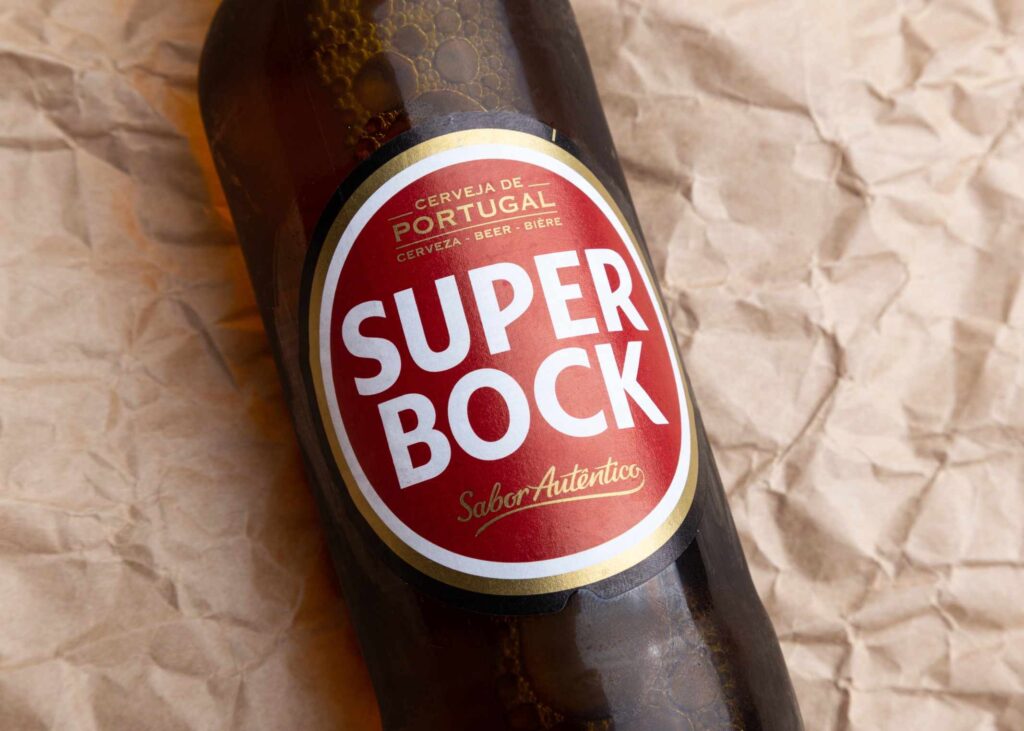What is Bock? In this article, you will learn interesting facts about Bock.
Bock beer, a type of strong and flavorful lager, has a rich history and some compelling characteristics that may surprise even seasoned beer enthusiasts. The roots of this distinctive beer style can be traced back to the city of Einbeck in northern Germany, where it first emerged as part of the Hanseatic league’s brewing tradition. Over the years, Bock beer has continued to evolve, gaining popularity in countries like the Netherlands, where it is considered an integral part of Dutch beer culture.
This bottom-fermented beer usually boasts an alcohol content of around 6.5%, presenting itself in various shades from dark copper to deep chestnut, and sometimes even auburn. Most Dutch Bock beers are characterized by their dark hue, slightly sticky texture due to malt sugars, and subtle bitterness. It is worthwhile to explore the different variations of Bock beer, as each offers a unique perspective on this age-old brewing tradition.
Beyond its rich flavor and smooth texture, Bock beer is steeped in fascinating stories and misconceptions. One such example is the origin of its name, which is often attributed to the German word for “billy goat” due to the images of goats that frequently adorn Bock beer labels.
However, the name is more likely derived from its historical connection to the city of Einbeck. As you delve into the world of Bock beer, you’ll uncover captivating tales and enticing flavors that make this beer style stand out from the crowd.
Table of Contents
Bock Beer Origins
Einbeck, Germany
Bock beer’s history can be traced back to the small German town of Einbeck, nestled between Kassel and Hannover. The town has records mentioning beer brewing dating as far back as 1378. Einbeck was renowned for its high-quality beer, which eventually caught the attention of Bavarians who imported it to Munich. They later invited Einbeck’s brewmaster Elias Pichler to teach them the brewing process, leading to the popularization of Bock beer in Bavaria.
Monks and Lent
The tradition of brewing bock beer is closely connected to monks and the Christian observance of Lent. Bock beers are known for their strong, full-bodied flavor, and high caloric content. They originally served as sustenance for monks during their fasting period, providing much-needed nourishment and energy. This strong beer style became a popular choice during Lent, when adhering to fasting rules was vital.
Hanseatic League
Bock beer’s roots can also be linked to the Hanseatic League, a powerful trade alliance in northern Europe. Einbeck, a member of the league, contributed to the popularity of its beer by gaining access to broader markets. The beer’s quality and reputation caught the attention of other regions, including Bavaria, which led to the spread of Bock beer across the continent.
In summary, Bock beer originates from the historic town of Einbeck, Germany and has strong connections with monks and the practice of fasting during Lent. The Hanseatic League played a crucial role in the beer’s expansion and popularity.
Bock Beer Varieties

Bock beer is a high-alcohol lager with a dominant malt character and moderately hopped flavors. This section covers the various sub-styles of bock beer, including Doppelbock, Eisbock, Maibock, Weizenbock, and Pale Bock.
Doppelbock
Doppelbock, also known as “double bock,” is a stronger version of the traditional bock beer. It usually has an alcohol content between 7-10% ABV, making it heavier and richer than the average bock. Doppelbock is characterized by its dark color, full-bodied maltiness, and a subtle hint of hops. It is often enjoyed as a winter beer due to its warming qualities and rich flavors.
Eisbock
Eisbock is an even stronger variation of bock beer with an alcohol content ranging from 9-15% ABV. It is created by freezing a doppelbock and removing the ice, which concentrates the remaining liquid, enhancing the flavor and alcohol content. Eisbock has a fruity, rich malt sweetness with a slight alcohol warmth. It is typically enjoyed as a dessert beer or sipping beer due to its intense flavor and high alcohol content.
Maibock
Maibock, or “May bock,” is a lighter and hoppier variation of bock beer that is typically enjoyed during the spring season. Maibock has an alcohol content similar to that of a traditional bock, around 6-7% ABV, but features a lighter color and a more pronounced hop character. This beer style is often enjoyed as a refreshing drink during warmer months, offering a perfect balance between maltiness and hoppiness.
Weizenbock
Weizenbock is a unique combination of bock beer and German wheat beer. It typically contains around 7-9% ABV, and its flavors combine the rich, malty character of bock with the fruity, spicy, and slightly sour notes of a wheat beer. A popular example of this style is Schneider Aventinus, which showcases a complex and satisfying flavor profile. Weizenbock is suitable for sipping and pairs well with a variety of foods.
Pale Bock
Pale Bock, also known as “Helles Bock,” is a lighter version of bock beer that features a pale, golden color and a noticeable hop aroma. Pale Bock usually has an alcohol content of around 6-7% ABV, similar to that of a traditional bock. This sub-style focuses on the balance between maltiness and hop bitterness, creating a refreshing and easy-drinking beer. Pale Bock is a popular choice among those who prefer a lighter, more approachable bock style.
International Bock Beers

In this section, we’ll explore the different types of Bock beers from various countries, specifically focusing on Dutch Bock, Belgian Bock, American Bock, and British Bock.
Dutch Bock
The Dutch Bock beer tradition is often considered to be the only true Dutch beer tradition. Most Dutch Bock beers are dark in color, ranging from dark copper to deep chestnut, and even auburn sometimes. These beers tend to be slightly sticky from the malt sugars and have a slight bitterness in their taste profile. The alcohol content in Dutch Bock beers typically hovers around 6.5% ABV. The Beerwulf website provides more information on these beers.
Belgian Bock
Belgian Bock beers are less specific in their characteristics, allowing for a greater range of flavors and a more diverse beer scene. As a result, these beers can vary significantly in color and taste. Belgian Bocks may not always adhere to traditional Bock beer styles, which adds to the variety and unique flavors offered by this country’s Bock beers.
American Bock
In America, Bock beers have been adopted and adapted, with some breweries producing variations such as the Texan-style Bock, which is often lighter and more palatable for a wider audience. American Bock beers can range from dark and malty to lighter and more refreshing in taste, while still maintaining an emphasis on the rich malt flavors that are characteristic of the traditional Bock beer style.
British Bock
Though not as commonly found, there are a few examples of British Bock beers. These beers usually focus on the strong, malty, and toasted qualities of the traditional Bock beer but are sometimes adapted and influenced by British brewing traditions. As a result, British Bock beers might offer a unique twist on the classic style, blending the robust and malty flavors of Bocks with the distinct brewing practices from the UK.
Each of these international Bock beers reflects the brewing heritage and cultural influences of its country of origin, thus adding unique dimensions to the traditional Bock beer style.
Bock Beer and Popular Culture

Bock Season
Bock beer is traditionally associated with specific seasons, particularly in countries known for beer production and consumption. Bock season mainly falls between March and April, as this strong, full-bodied brew is ideal for welcoming the warmer months. This period is often characterized by beer festivals and events that celebrate the various styles of bock beers.
Easter and Christmas
Bock beers are not only enjoyed during the bock season but also have a connection to major Christian holidays like Easter and Christmas. These seasonal beers are brewed in different styles, such as Maibocks during springtime, which are lighter in color and hoppier in taste than their traditional counterparts. On the other hand, Christmas Bocks or Weihnachtsbocks are more robust, darker, and maltier, perfect for cold winter nights.
Goat Symbolism
Bock beer often features goats on its labels and promotional materials, as “bock” means “billy goat” in German. The goat symbolism can be traced back to the beer’s origin in the town of Einbeck in northern Germany, which was part of the Hanseatic trade league. The city of Einbeck lent its name to the beer, which eventually transformed into “Ein Bock” and finally “bock.” Over time, brewers playfully embraced the goat connection, making it an essential part of bock beer’s imagery and marketing.
In conclusion, bock beer plays a significant role in popular culture through its association with specific seasons and Christian holidays. Its rich history, unique flavors, and goat symbolism make it a standout among various beer styles, reflecting a distinctive combination of tradition and creativity that continues to enchant beer lovers worldwide.
Bock Beer Characteristics
Alcohol Content
Bock beer is known for its high alcohol content, typically higher than that of a standard lager. It varies in alcohol by volume (ABV) depending on the style, but generally ranges from 6% to 14% ABV. This high-alcohol content is a result of using bottom-fermenting yeast in cold temperatures during the brewing process1.
Flavors
The dominant flavor profile of bock beer focuses on malt characteristics, with richer and deeper flavors than pilsners or IPAs. Bock beers usually have a smooth, full-bodied taste and a mild to moderate sweetness, often featuring notes of toasted bread, caramel, and occasionally raisins or dark fruits. Despite the strong malt presence, bock beers tend to have a balanced and clean finish. It’s worth noting that while bock beers are malt-forward, they’re less bitter than IPAs, but offer more depth and complexity than lighter lagers2.
Bitterness
Bock beers have a moderate bitterness, which plays a secondary role in their flavor profile. Their IBUs (International Bitterness Units) are typically lower than IPAs but slightly higher than pilsners. The use of hops in bock beer is more for balance rather than to impart strong bitterness or hop flavors. This balance helps to create a harmonious blend of malt sweetness and bitterness, which sets them apart from more hop-forward beer styles3.
Notable Bock Beers and Breweries
Paulaner Salvator
Paulaner Salvator is an iconic Doppelbock beer from Paulaner, one of the six historic Munich breweries. Rich in malt sugars, it features a full-bodied flavor and a high alcohol content of around 7.9%. With a history dating back to the Paulaner monastery, this beer has a deep-rooted connection to the brewing traditions of Bavarian monks.
Spaten’s Optimator
Spaten’s Optimator is another classic Doppelbock with a rich and balanced flavor profile, featuring notes of caramel, toasted malt, and dried fruits. Brewed by the venerable Spaten-Franziskaner brewery in Munich, Germany, this high-alcohol beer (7.6% ABV) has a notable history in the evolution of the Bock style as we know it today.
Ayinger Celebrator
Ayinger Celebrator is a world-renowned Doppelbock hailing from Bavaria. This bold beer boasts an impressive combination of sweet maltiness and pronounced bitterness. With a toasty and nutty profile, it is widely acclaimed for its balanced and complex flavor. At 6.7% ABV, Ayinger Celebrator has earned a devoted following among beer aficionados.
Samichlaus
Samichlaus is an extraordinary Bock, and at one time, it held the title of the world’s strongest beer with an ABV of 14%. Brewed annually on December 6th (St. Nicholas Day) and then aged for 10 months before bottling, this Swiss-origin beer is cherished for its unique character and rich flavors of caramel, molasses, and chocolate.
Weihenstephaner Vitus
Weihenstephaner Vitus, brewed by the oldest brewery in the world, is a widely admired Weizenbock characterized by its delicate balance of fruity esters and spicy phenolic notes. This refreshing beer showcases flavors of banana and clove, together with a soft maltiness, and an alcohol content of 7.7% ABV, making it a popular choice among Bock beer enthusiasts.
Low-Alcohol and Alcohol-Free Bock Beers
Bock beer is a popular style that originated in Germany, and it has various sub-styles that cater to different preferences. In this section, we’ll focus on low-alcohol and alcohol-free Bock beers, including Radlers, Wheat Bocks, and Top-Fermented Bocks.
Radlers
Radlers are a refreshing option for those who enjoy the taste of Bock beer but prefer a lower alcohol content. These beverages are typically a mixture of beer and carbonated lemonade, fruit juice, or soda, resulting in a drink with reduced alcohol levels. The combination of a Bock beer with fruity flavors in Radlers offers a perfect balance between the malty and sweet notes, making it a popular choice for summer sipping.
Wheat Bocks
Wheat Bocks are another low-alcohol option that draws inspiration from the traditional Bock beer style. These beers incorporate a significant proportion of wheat malt along with the standard barley malt, giving them a distinct, light, and slightly hazy appearance. With their lower alcohol content and unique flavor profile, Wheat Bocks offer a refreshing alternative for those looking to enjoy Bock-style beers but with less alcohol.
Top-Fermented Bocks
Top-Fermented Bocks are a rare and intriguing subcategory within the world of low-alcohol and alcohol-free beers. Unlike conventional Bocks, which undergo bottom fermentation, Top-Fermented Bocks use a different yeast strain that ferments at warmer temperatures. This fermentation method yields a unique array of fruity esters and spicy phenolic compounds in the final product. The result is a delicious Bock-style beer with a noticeably lower alcohol content yet packed with rich flavors and aromas.
In conclusion, the low-alcohol and alcohol-free Bock beer market is filled with exciting options for those who enjoy the taste of Bock but prefer lighter alternatives. Radlers, Wheat Bocks, and Top-Fermented Bocks each offer a distinctive twist on the classic style while keeping alcohol levels in check.



